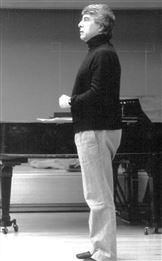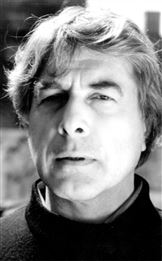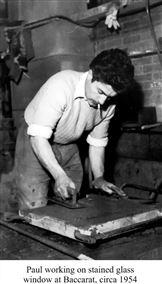Paul Reynard
Bill Jordan
I
first met Paul Reynard in 1971, when he stopped by the print shop during a Sunday workday at St. Elmo, the Gurdjieff Foundation house in San Francisco, to see what the team was working on. I was in my late twenties and he in his mid-forties. When he gave his surname during our introductory greeting, I tried to cover my feeling of insecurity with cleverness, saying, “Oh, like the fox!” Paul just smiled quietly with an affirmative nod and proceeded to look around the shop. Little did I know then that, during the next thirty-four years, I would work under his direction with accelerating intensity.
 I had just returned to the Bay Area after serving two years in the Army. Significant changes had taken place in San Francisco while I was away. Under Lord Pentland’s direction, new groups and Movements classes had been formed to accommodate the many new people being drawn to the Gurdjieff teaching. Following the untimely death of Alfred Etievant, who had directed the Movements in North America through the fifties and early sixties, Jeanne de Salzmann had sent Paul Reynard to continue the work with Movements there. After relocating from Paris to New York, Paul had begun coming to San Francisco regularly. From his experience as a young man with Gurdjieff and years of work with Mme. de Salzmann, particularly in relation to the Movements, Paul was uniquely suited for this role. The synchronous arrival of Paul with expanding classes of young people and the construction of a new hall marked the beginning of a new era of study of the Movements in San Francisco.
I had just returned to the Bay Area after serving two years in the Army. Significant changes had taken place in San Francisco while I was away. Under Lord Pentland’s direction, new groups and Movements classes had been formed to accommodate the many new people being drawn to the Gurdjieff teaching. Following the untimely death of Alfred Etievant, who had directed the Movements in North America through the fifties and early sixties, Jeanne de Salzmann had sent Paul Reynard to continue the work with Movements there. After relocating from Paris to New York, Paul had begun coming to San Francisco regularly. From his experience as a young man with Gurdjieff and years of work with Mme. de Salzmann, particularly in relation to the Movements, Paul was uniquely suited for this role. The synchronous arrival of Paul with expanding classes of young people and the construction of a new hall marked the beginning of a new era of study of the Movements in San Francisco.
Devoted to the Work and to the Movements, Paul had a long-term vision of what he wished to accomplish, both inwardly and externally. In 1972, during one of the monthly trips he made to San Francisco with Lord Pentland, Paul made a special point of visiting each of our Movements classes. Struggling to stay in touch with ourselves as we engaged in exercises and dances, we felt his attention on us. Based on his observations, Paul selected a group of men and women for a new class to which he would bring a demanding program to be developed over many years. From that class, he gradually selected a young cadre to serve as Movements assistants in the decades ahead.
In a class with Paul, we felt guidance not just from his words, but from his being. Sometimes we understood what he wished to convey just from the attention he turned toward us, felt his inner authority, and were glad to submit to it. We responded to the strong demand he made on us because we saw how he made the same demand on himself. He would not let us become complacent or satisfied, always asking us to bring more of ourselves to the dance, dervish, or prayer at hand. He sometimes asked us to stop and hold difficult postures, to sense our positions, and, without looking, to correct or refine them. He taught us not to be satisfied until we were able, through sensation, to take each position to the best of our ability. Taking us further, he enjoined us to discover the movement between positions. When we lapsed into an habitual attitude, Paul saw it and called us back with a strong word or fierce look. Paul had no patience for any kind of pretense, but he showed generosity and warmth to those who worked. At the same time that he demanded our best effort in filling the form of a Movement, he always gave the inner work precedence, constantly reminding us that we were there to wake up, to see ourselves, to struggle with our automatism, and to gradually bring the whole of ourselves to a Movement in the service of a new level of attention. In his class, we came to our own living understanding of why the Movements are called Sacred Dances.
During one of Paul’s monthly visits to San Francisco, an event took place during a Movements class that showed how much we trusted him, and, consequently, how we were learning to trust something more essential in ourselves. We were working on a fast Multiplication, a type of movement in which people in different files exchange with one another according to the principles of objective laws brought by Mr. Gurdjieff. As we moved, he reminded us to sense those near us and maintain the spacing between our rows and files. Just as we were about to move forward in another brisk exchange, Paul asked us to close our eyes. I remember obeying without hesitation, while staying with my movement and continuing to try to sense those near me. I think all of us had a similar experience. Eyes closed, we moved forward without fear, without diminishing our speed, and without touching one another. Very soon, he asked us to open our eyes again, but in trusting Paul, we each had the rare experience of trusting our own inner authority.
Paul knew how to create conditions to elicit a struggle between our automatic, egoistic natures and our wish for consciousness. Once, when Paul came to work with a class for which another assistant and I were responsible, he gave all of his attention to my colleague and ignored me completely as if I wasn’t there. Standing unacknowledged at the side of the class for the first quarter-hour, I felt humiliated. Just as a rising current of self-pity began to trigger distressing thoughts, Paul asked the class to form a large circle and, now seemingly finally recognizing my existence, asked me to go to the center of the circle. At Paul’s signal, the pianist began to play the music for a Movement that I knew well. Paul, standing behind me so that I couldn’t see him and speaking in an unusually low voice, asked me to show and hold the first position of the Movement for those in the circle around me. Remaining still in that first position, I felt a rising wish to give the whole of myself to the compelling demand coming from Paul, the Movement, the music, and the others. As I went on, listening carefully for Paul’s next indication and taking each position of the prayer, the struggle that ensued illuminated my inner world to reveal the completely automatic nature of my subjective reactions and bring the certainty that they were not me. Although associations linked to those reactions continued to revolve, I was free of them. What mattered was serving the moment-to-moment vitality of active presence that had appeared, linked to a new sense of cooperation between my mind, my body, and my feeling.
 Paul was especially demanding on the pianists who played for his classes, but the musicians responded with their best because he was so sensitive to rhythm, melody, and harmony. He knew exactly what he wanted from a musician in terms of tempo, dynamic range, and feeling. Whether he asked the pianist to improvise an accompaniment or play the music specially composed for a Movement, the vibrant connection between Paul and the pianist spread to us in the class, further inspiring an all-round engagement. Paul was also a wonderful drummer, often picking up the small hand drum we kept in the Movements hall to beat a rhythm until its energy filled the room, circulating in our bodies and our feeling.
Paul was especially demanding on the pianists who played for his classes, but the musicians responded with their best because he was so sensitive to rhythm, melody, and harmony. He knew exactly what he wanted from a musician in terms of tempo, dynamic range, and feeling. Whether he asked the pianist to improvise an accompaniment or play the music specially composed for a Movement, the vibrant connection between Paul and the pianist spread to us in the class, further inspiring an all-round engagement. Paul was also a wonderful drummer, often picking up the small hand drum we kept in the Movements hall to beat a rhythm until its energy filled the room, circulating in our bodies and our feeling.
Of course, we in San Francisco saw Paul mostly from our own limited perspective. During those years, Paul was engaged just as intensively with people at other work centers in North America, especially in New York, leading classes, training people to help, and assisting those responsible in each center to develop their own programs. We knew that he was also connected internationally, working with people at centers in Europe, South America, and perhaps other places. He traveled often to his native France to work with Mme. de Salzmann and senior leaders in Paris. For several decades, he was a key participant in the senior Movements classes so carefully prepared by Mme. de Salzmann and recorded in her films.
After the death of Lord Pentland in 1984, Paul directed not only our program of Movements in San Francisco, but the general work here as well. He brought his influence to our central council, to our groups, and to each of the teams that practiced crafts, construction, or music. In exchanges during meetings and at communal meals, he encouraged us but never let us be satisfied, calling us to question what we were trying. His leadership in our quiet sittings became very important, as his presence and clear direction helped bring conditions in which we experienced ourselves as we were and as we might become. He introduced new tasks to craft teams and met with them regularly to encourage their interest and perseverance. He gave essential inspiration and guidance to the architects and builders dedicated to long-term construction projects at properties in the city and country. When he observed someone’s genuine interest in a particular line of endeavor, such as pottery or music, Paul encouraged them, bringing up the discipline in question each time he saw them, and showing how that work could serve their efforts toward self-study and self-development. For many people, Paul wasn’t just another senior leader; they considered him to be their teacher. But though he spoke with strength and authority, Paul always took a modest stance, letting us know that he himself was in question too.
Paul’s leadership responsibilities also increased on the East Coast, where he became Co-President of the Gurdjieff Foundation of New York. He worked tirelessly with senior leaders in New York and other major centers to bring people from the groups together to exchange questions and search for the continually elusive meaning of the way transmitted by Gurdjieff. With an eye to the future, he cultivated relationships between those of us in San Francisco and our colleagues in New York and other centers, inviting us to special events in New York and including them in our summer work periods near San Francisco. Paul also strove to reunite groups that had grown apart due to apparently disparate views of elements of Gurdjieff’s teaching; when he was successful, those involved were grateful. Thanks to his vision, many groups continue to benefit from the support of these relationships.
 Paul understood that the Movements were an essential part of Gurdjieff’s teaching and would lose their meaning if taken as a separate discipline. Passionate about protecting the integrity of the Movements in the face of the explosion of media on the Internet, Paul took great care to safeguard the Movements films of Mme. de Salzmann. Paul spoke to us often about Mme. de Salzmann, and always with respect and devotion. Soon after she died in 1990 at the age of 101, Paul came to San Francisco to be with us to commemorate her passing. In reverence, he gathered us together to work on a program of Sacred Dances.
Paul understood that the Movements were an essential part of Gurdjieff’s teaching and would lose their meaning if taken as a separate discipline. Passionate about protecting the integrity of the Movements in the face of the explosion of media on the Internet, Paul took great care to safeguard the Movements films of Mme. de Salzmann. Paul spoke to us often about Mme. de Salzmann, and always with respect and devotion. Soon after she died in 1990 at the age of 101, Paul came to San Francisco to be with us to commemorate her passing. In reverence, he gathered us together to work on a program of Sacred Dances.
Paul’s life work as an artist and teacher ran parallel to his all-round engagement in the Gurdjieff Work. Born in Lyon, France in 1927, by his teens Paul had become an apprentice to the painter Claude Idoux. After the war, he moved to Paris where he attended the Académie des Beaux-Arts and studied with Fernand Léger and Jean Souverbie. Later on, Paul designed and installed stained glass windows in churches throughout France, notably at the church of St. Rémy in Baccarat. Continuing his central work of drawing and painting, Paul exhibited his pieces in Europe and North America, and taught at art schools in France and the United States, including the School of Visual Arts in New York City. The drawings and paintings he created in the United States are showcased in his book, Paul Reynard, Works in America.[1]
Paul was introduced to the Work by Claude Idoux in 1946 when he joined a group led by Henriette Lannes in Paris. The following year he began Movements classes with Mme. de Salzmann and Mr. Gurdjieff. He participated in all but the first Movements films, and instructed classes in Paris with Marthe de Gaigneron. When he moved to the United States at Mme. de Salzmann’s request, he assumed responsibility for the Movements in New York and related groups in the United States and Canada.
Those interested in learning more about Paul’s approach to the Gurdjieff Movements may discover elements of it in his essay, Dances are for the Mind.[2] Those who wish to understand a little more about the man himself and his lifelong study of attention should read his short piece, Dimensions of Attention.[3]
Paul died on October 28, 2005, just a few months after living and working closely with some of the San Francisco groups at our country place in Northern California. At our last communal meal during that period, he spoke quietly about his illness, terming it “his situation,” and calling those of us gathered around him “his family.” Paul Reynard’s influence has touched the lives of men and women around the world, not just in relation to the inner work of Movements he transmitted to them, but also in the way that he supported each individual’s search for meaning. Those whom Paul prepared to continue the transmission of the Work carry a feeling of gratitude and a sense of responsibility for passing on what they have been able to understand of all they received from him. In light of the scale of Paul’s spreading influence, the brief remarks in this text reflect only subjective fragments of the full picture of the man, an authentic seeker who called to our wish to become real men and women.
~ • ~
Bill Jordan has been a member of the Gurdjieff Foundation of California since 1965. Under the guidance of Lord Pentland and Paul Reynard, he began leading groups and Movements classes in the late 1970s.